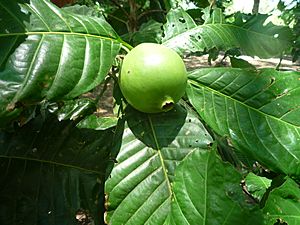Borojó facts for kids
Quick facts for kids Borojó |
|
|---|---|
 |
|
| Scientific classification | |
| Synonyms | |
|
Alibertia patinoi, often called borojó, is a small tree that grows in tropical rainforests. It usually reaches about 2 to 5 meters (6 to 16 feet) tall. This tree is special because it's one of the few plants in the Rubiaceae family (which includes coffee!) that produces edible fruit.
Borojó is native to some of the wettest places on Earth. You can find it growing naturally in the Chocó Department of northwestern Colombia and in the Esmeraldas Province of northwestern Ecuador. The name Borojó comes from the Emberá people. It means "head-shaped fruit" or "round fruit," because boro means head and jo means fruit. This tree has also been found in Panamá, Venezuela, and Costa Rica.
How Borojó Grows
The Borojó tree has bark that is grey-brown. Sometimes, it can have two or three smaller trunks along with its main one. This plant loves a lot of moisture! It needs high humidity, usually over 85%. It also needs warm temperatures, averaging at least 25 °C (77 °F). Even though it likes warmth, it can handle short periods of cold weather or even floods.
The Borojó Fruit
The fruit of the Borojó tree is quite large. It's usually round and brown, measuring about 12 cm (5 inches) across. Each fruit weighs between 740 and 1000 grams (about 1.6 to 2.2 pounds). A big part of the fruit, about 88%, is its soft pulp. Inside, you can find many seeds, from 90 up to 640 in one fruit!
Borojó is packed with good things for your body. It has high levels of protein, ascorbic acid (which is Vitamin C), calcium, and iron. It also has a lot of phosphorus.
People use Borojó in many ways. It's used to make jam, wine, and desserts. Local communities also use it in traditional medicines. They believe it helps with things like high blood pressure, breathing problems, and even malnutrition. You might also find Borojó extract sold online as a healthy food supplement.
Scientists have studied Borojó and found it has many healthy plant compounds called polyphenols. These compounds are good for you!
Growing Borojó
Farmers grow Borojó on a large scale. About 3,000 hectares of land are used to cultivate this special fruit.
Similar Fruits
There are a few other fruits that are similar to Borojó. One is Alibertia sorbilis, which is very much like Borojó and also grown for sale. Another one is called Borojó de la Amazonia (Amazonas borojo), or Duroia maguirei. This is a wild plant from a different group in the same plant family. It can grow taller, up to 8 meters (26 feet), and has a smaller fruit that is also edible.
See also
 In Spanish: Borojó para niños
In Spanish: Borojó para niños

